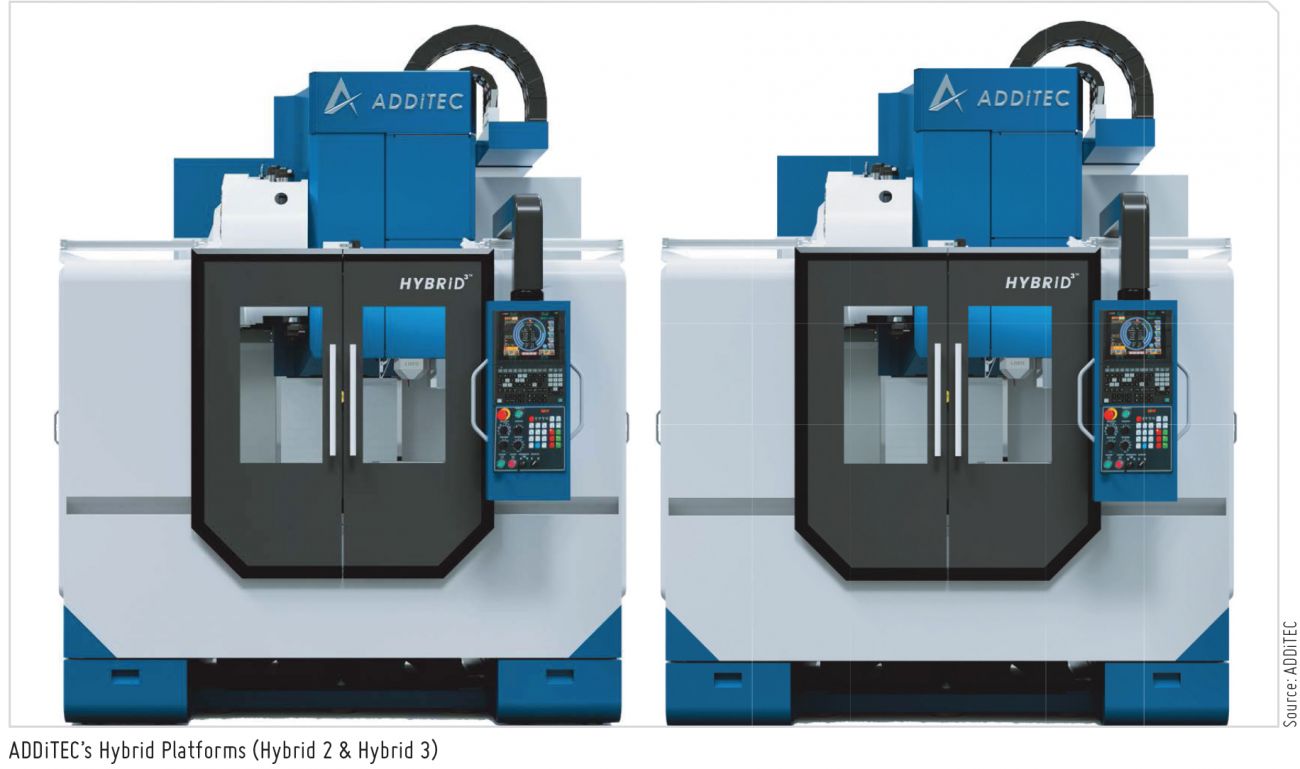TACKLING THE TIME-TO-MARKET CHALLENGE

In a world where speed, precision, and adaptability define success, manufacturers are under constant pressure to enhance performance and sustainability while accelerating time-to-market — a key competitive advantage. With its Hybrid and Laser Metal Jetting (LMJ) technologies, ADDiTEC brings that advantage directly to the shop floor.
Traditional manufacturing methods often require long lead times, expensive tooling, and extensive post-processing. Additive manufacturing, in contrast, can dramatically shorten development cycles by enabling near-net-shape production directly from digital designs. However, not all AM technologies are created equal. Many legacy metal AM systems still involve complex workflows, powder management, or extensive finishing steps, slowing down deployment and limiting accessibility.
ADDiTEC’s Hybrid and Liquid Metal Jetting (LMJ) platforms represent major leaps toward that goal.
A Hybrid Approach
Our Hybrid 2 and Hybrid 3 platforms integrate three key functions in one compact footprint: • Laser Wire Directed Energy Deposition (LDED) for high deposition rates, • LMJ for fine resolution features, and • CNC Machining for precision finishing.
This combination ensures manufacturers can go from digital model to finished metal part — all in a single machine, without external handling or setup changes.
By eliminating transfers between different machines and reducing post-processing steps, the Hybrid workflow dramatically accelerates the delivery of parts. Whether it’s building complex prototypes or repairing high-value components, the Hybrid system enables same-day production cycles — something unthinkable with traditional processes.
Our unique ring-shaped laser beam and closed-loop monitoring ensure consistent thermal control and high-quality builds. Combined with coaxial wire feed and adaptive melt pool control, this results in superior dimensional accuracy and high deposition efficiency — key requirements for first-time-right builds.
Hybrid 2 Platform
The Hybrid 2 Platform features LMJ, an innovative additive process offering key advantages to hybrid manufacturing. By utilizing low-cost welding wire, LMJ enables the production of near-net shape parts. This process is notable for its ability to achieve high-resolution metal printing, allowing for the creation of fine, detailed geometries that are often challenging for other metal additive processes. The hybrid system further enhances LMJ by incorporating subtractive machining capabilities. These enable post-printing operations to refine surface finishes and achieve tight tolerances. The combination of flexibility and precision makes LMJ particularly suitable for industries requiring high-performance, intricately designed components.
Hybrid 3 Platform
The Hybrid 3 Platform integrates LMJ, LDED, and CNC machining within a single platform. This multi-tech approach combines the benefits of two additive processes — LMJ and LDED — both of which use low-cost welding wire to produce near-net shape parts.
LMJ enables high-resolution capability, while LDED offers high deposition rates, making the system suitable for a wide range of part sizes and applications. Together, these technologies support multi-material manufacturing, enabled by dual additive processing heads. The built-in subtractive process (CNC machining) allows for post-processing to achieve the required surface finish and tight tolerances for parts printed using the two additive processes.
Key Features of ADDiTEC’s Hybrid Platforms
Multi-Technology Integration: Both platforms integrate LMJ and CNC machining, while the Hybrid 3 adds LDED for higher deposition rates and multi-material capability.
Cost Efficiency: Designed to reduce the cost of goods sold (COGS) through low-cost wire feedstock and compact equipment footprints, the platforms ensure affordability without compromising capability.
Full Material Utilization: LMJ technology ensures 100 percent usage of raw material, eliminating waste by forming parts with precisely ejected molten metal droplets.
Complex Geometry Capability: Both systems have successfully produced 90° overhangs and intricate gyroid structures.
Advanced Processing Heads: Proprietary LMJ and LDED heads are the result of over a decade of development, offering industry-leading performance.
Superior Surface Finishing: Integrated CNC machining allows for high-quality post-processing, ensuring parts meet strict surface finish and dimensional accuracy requirements.
LMJ: Drop-on-Demand Innovation
When we acquired Elem Additive Solutions from Xerox Corporation, we inherited over a decade of development and more than 300 patents related to LMJ technology. This proprietary process uses molten metal droplets ejected on demand to form parts — a radically different approach from traditional powder-based systems.
LMJ’s key advantages:
- It eliminates the need for powder handling, which improves safety and reduces waste.
- It avoids issues like shrinkage or warpage, enabling the production of parts with tight tolerances.
- Since the process requires no post-processing steps such as sintering or debinding, it simplifies the overall workflow.
- Moreover, with 100 percent material utilization, LMJ enables truly zero-waste production.
Easy to Deploy, Easy to Scale
One of the most overlooked barriers to adopting AM is complexity. Many systems are costly to maintain, require extensive training, and demand specialized facilities — particularly when powder-based processes are involved.
At ADDiTEC, we’ve taken a different path by designing systems that are plug-and-play ready, easily operable in standard industrial environments, and safe, with no explosion or toxicity risks. They’re also accessible to non-specialist operators after only minimal training, removing the steep learning curve that often hinders adoption.
This means faster ramp-up for new users, lower barriers to entry, and faster go-to-market cycles for innovative applications.
| Reducing time-to-market is not just about speed — it’s about achieving efficiency and sustainability. ADDiTEC’s Hybrid and LMJ systems deliver on both fronts. They offer up to 40% lower total cost of ownership compared to traditional powder-bed systems. |
Economic and Environmental Gains
Reducing time-to-market is not just about speed — it’s about achieving efficiency and sustainability. ADDiTEC’s Hybrid and LMJ systems deliver on both fronts. They offer up to 40 percent lower total cost of ownership compared to traditional powder-bed systems. Their compact, self-contained design helps reduce facility costs, while the ability to use standard wire or recycled materials significantly lowers input expenses. What’s more, with 100 percent material utilization, these systems generate near-zero waste.
Real-World Applications
From restoring aerospace components to manufacturing custom tooling on the shop floor, our systems are already proving their value in the field.
Key application areas include:
- Tooling and fixturing for high-mix environments
- Spare part production in Defence and Oil & Gas
- Rapid prototyping for new product development
- On-demand manufacturing close to point-of-use
Each application underscores how metal AM, when thoughtfully engineered, can redefine supply chains and shorten product launch timelines.
 |
BRIAN MATTHEWS |




 Facebook
Facebook.png) Twitter
Twitter Linkedin
Linkedin Subscribe
Subscribe